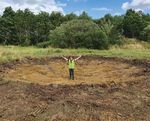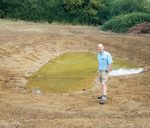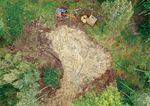Habitat creation and restoration for great crested newts - NatureSpace District Licensing scheme: compensation sites update
←
→
Page content transcription
If your browser does not render page correctly, please read the page content below
Habitat creation and
restoration for great
crested newts
JANUARY 2020
NatureSpace District Licensing scheme:
compensation sites update
A new clean water pond created at Whitecross Green Wood SSSI, Cherwell District CouncilForeword Introduction
The Newt Conservation Partnership has now been the delivery body of the The Newt Conservation Partnership has been established to create high quality aquatic
great crested newt District Level Licensing scheme in the South Midlands for and terrestrial compensation habitat for the NatureSpace great crested newt District
two years. Results from our first year of monitoring, a vital part of the scheme, Licensing scheme, which is currently operating in 16 LPAs across the Midlands.
are very encouraging: we have seen great crested newts colonising ponds
What is District Licensing?
almost immediately at some sites and the quality of the new habitats is
The great crested newt District Level Licensing scheme is an alternative approach to newt mitigation licensing for
generally looking excellent.
developments. Funds from developers are used to implement a long-term, landscape-scale conservation strategy
District Licensing is a new strategic approach to compensating the impacts of development on great for great crested newts, while streamlining the process for developers and reducing the delays they face.
crested newts. Our focus is on making sure that we see an overall gain in the status of the newt
The scheme was developed by a consortium of organisations
populations at the District Level, and ensuring these populations are healthy and expanding across
including NatureSpace and the national conservation non-
the countryside. This will result in better conservation outcomes rather than trying to retain populations
governmental organisations Amphibian and Reptile Conservation
with poor long-term viability in urbanised, heavily managed environments.
Trust and Freshwater Habitats Trust.
By providing plenty of high quality, clean water ponds with natural meadows, woodland and scrub for
terrestrial habitat, there is a much better chance that newts will not only survive in our landscapes but
Strategic conservation
spread back to their former range. Importantly, this is supported by an extensive monitoring programme For every pond lost which is predicted to be occupied by great
designed to ensure the scheme is delivering its conservation goals. crested newts, we are required to create a minimum of four new
ponds (although we aim to create eight new ponds for every one
Building on the long experience of the Amphibian and Reptile Conservation Trust and Freshwater
lost), as well as ensuring suitable terrestrial habitat is in place.
Habitats Trust, the new approach could see the start of a better future for one of our most charismatic
animals and the rich and diverse freshwater and terrestrial habitats they depend on. Once again, Habitat creation is guided by the District Licensing scheme’s
great crested newts could become common and abundant, a real example of net gain for freshwater Implementation Strategy, which sets out the objectives of the scheme
biodiversity. for great crested newt conservation, including conservation priority
zones (see map on centre pages), best practice principles for newt
habitat creation and management, and a monitoring framework Great crested newt
Dr Tony Gent Dr Jeremy Biggs
to assess the outcome of the scheme for great crested newt
Amphibian and Reptile Conservation Trust Freshwater Habitats Trust The largest of our native UK
conservation at the site and landscape scales.
Directors for the Newt Conservation Partnership newt species, great crested newt
Ongoing support numbers are declining across the
As part of our monitoring programme, we make annual visits to UK and Europe due to habitat loss
compensation sites to assess if any management is required and land-use change. Newts prefer
to maintain the habitat in good condition for great crested newts. clean water ponds with plenty
of vegetation and no fish. Once
Management of the ponds and terrestrial habitat is carried out by
mature, newts spend the majority
both the Newt Partnership and the landowner, with the landowner
of their time in terrestrial habitat
receiving a management plan and annual payments to cover the
and usually only return to ponds
cost of any management needed. Agreements with landowners are
during spring to breed.
on a 5-year rolling contract to allow for flexibility, with a commitment
to provide funding to landowners for at least 25 years.
One of the first ponds
created for the NatureSpace
District Licensing scheme
at Shabbington Wood SSSI.
Staff members of the Newt Conservation Partnership,
Amphibian and Reptile Conservation Trust and
2 Freshwater Habitats Trust. 3Compensation sites
The Newt Partnership was founded in 2018 and already we have created 57 and
restored 8 clean water ponds across 26 sites. We are currently well ahead of impacts
from development (to date, six ponds have been lost to development through the
District Licensing scheme). We have ambitious plans for larger-scale, multi-phase
habitat creation projects to begin in 2020.
The new ponds at Millenium Woodland are regularly visited
Compensation sites where ponds have been by dog walkers, therefore this pond was fenced to reduce the
negative impacts from dogs (Milton Keynes Council)
created or restored as part of the District
Licensing scheme
A landowner with one of his three new clean water ponds created
on a farm in Bedfordshire (Central Bedfordshire Council)
At Robinswood Hill County Park, three over-
shaded, late succession ponds were restored
(Gloucester City Council)
Two new ponds created at the Nagshead RSPB Inspecting new ponds at Leaches Farm
reserve (Forest of Dean District Council) (Aylesbury Vale District Council)
© Alex Robinson
© James Gillies
Four new ponds created on a privately owned farm Supervising creation of three new ponds at a farm in Oxfordshire Our very first pond at Shabbington Woods SSSI Aerial view of newly dug woodland pond at Whitecross
in Gloucestershire (Cotswold District Council) (Vale of White Horse District Council) (Aylesbury Vale District Council) Green SSSI (Cherwell District Council)Great crested newt best practice Monitoring our success
habitat creation and management Our compensation sites are surveyed annually to monitor great crested newt
populations and evaluate management requirements of the aquatic and terrestrial
We aim to increase the number of high quality occupied ponds and extent of habitat. In addition, we are also carrying out landscape-scale monitoring across the
suitable terrestrial habitat for newts, while also improving landscape connectivity Midlands to assess background trends in the wider great crested newt population.
by linking occupied sites. Site selection is key to the delivery of high quality
aquatic and terrestrial habitat for great crested newts. Results of 2019 monitoring
Our compensation sites are carefully chosen so that new or In spring 2019 we began our first year of monitoring,
restored ponds have a clean water source, a high chance of and considering many of the ponds were only a
population viability and are within range of an existing newt few months old at the time of survey, results were
population to maximise the chance of natural colonisation. promising.
We aim to reach a Habitat Suitability Index of 0.7 for each We surveyed all compensation sites (12 in total)
pond, and undertake extensive pre-surveys to ensure we are using environmental DNA testing and results
not negatively impacting on existing high value biological or confirmed that great crested newts had colonised
archaeological features. new ponds in 42% of sites. Observational surveys
© Fred Holmes
also noted the presence of newt eggs in two ponds,
Pond design
demonstrating the created habitat was being used
We aim to create ponds which are part of a network or complex for breeding within 12 months.
as this provides greater diversity for newts and other wildlife, while During population monitoring, common toads were found
also improving their resilience to impacts such as climate change. Where population assessments were undertaken,
breeding at three out of four sites
Ponds are designed to have extensive shallow margins as these peak counts of newts in created ponds, in some
areas provide a rich habitat for plants and insects, which in turn cases, exceeded those in existing ponds on the same site. Mean Habitat Suitability Index of most ponds
provide prey for birds, amphibians and small mammals. We create (all less than one year old at the time of assessment) has reached or exceeded our target of 0.7, and
permanent and semi-permanent ponds as both are suitable for we are confident that once matured and vegetated all ponds will have exceeded this target.
great crested newts and important for wildlife. Understanding the substrate is crucial Results from this first year of monitoring provide a baseline for future surveys and we expect to see continued
and informs a pond’s design expansion of newt populations and increased pond occupancy. We will use feedback from this monitoring
Terrestrial habitat to continuously evaluate our pond design and site selection process to ensure our habitat creation benefits
To date, the majority of our compensation sites have been located in high quality semi-natural habitat great crested newts and other wildlife as much as possible.
– woodland, scrub and rough grassland. By creating networks of clean water ponds away from existing
breeding ponds, but within dispersal distance, we have expanded the amount of high quality terrestrial Wider benefits
habitat directly available to great crested newts (i.e. within 250 m of a breeding pond) by at least 298 Our habitat creation is not only benefiting great
hectares. This is critical for newts as they spend most of their life in terrestrial habitat. crested newts, but also other freshwater and
Now that the scheme is better established, we have the opportunity to undertake more ambitious projects pond-associated wildlife.
by choosing sites where there is scope for improving or restoring low-quality terrestrial habitat, including While carrying out population monitoring at a sub-
grassland and arable land. set of our compensation sites, we found that three
out of four sites had already been colonised by the
UK Priority species common toad, and all sites had
been colonised by smooth newt and common frog.
In future, we aim to carry out more extensive
plant and animal surveys as part of the monitoring
programme to assess how other species are using
the created habitat.
A male and female great crested newt and a male
smooth newt caught during bottle trapping at one of
the compensation sites
Examples of hibernacula created using cut timber,
spoil and brash at Rushbeds Wood and Robinswood
Hill Country Park
For more information on pond creation see ARC’s Amphibian Habitat Management Handbook More information on the monitoring programme can be found on our website, or contact us to
6 (www.arc-trust.org.uk) and the Million Ponds Project Toolkit (www.freshwaterhabitats.org.uk). request a copy of our Implementation Strategy. 7About us “All the staff at the Newt
Partnership have been incredibly
The Newt Conservation Partnership is a not-for-profit, community-
benefit society whose sole purpose is creating and managing high friendly, enthusiastic and
quality habitat for great crested newts, using funds from developers. professional. The process from
Our staff are all seconded from the Freshwater Habitats Trust
the initial contact up to contractors
(www.freshwaterhabitats.org.uk) and Amphibian and Reptile
Conservation Trust (www.arc-trust.org.uk). finishing the ponds has been
Our partner NatureSpace Partnership works with developers and
flawless. I look forward to
participating local authorities to assess development proposals developing further projects.”
under the new District Licensing scheme, and advise developers Nigel Fisher
on the scheme’s requirements. More information can be found Conservator of Wytham Woods,
on their website: www.naturespaceuk.com. University of Oxford
© Piet Spaans
Participating LPAs currently include: Aylesbury Vale District Council, Bedford Borough Council, Central Bedfordshire Council,
Cheltenham Borough Council, Cherwell District Council, Cotswold District Council, Forest of Dean District Council, Gloucester City
Council, Milton Keynes Council, Oxford City Council, South Oxfordshire District Council, South Northamptonshire Council, Stroud
District Council, Tewkesbury Borough Council, West Oxfordshire District Council and Vale of the White Horse District Council.
Newt Conservation Partnership
c/o Bury Knowle House, North Place, Oxford, OX3 9HY
@NewtPartnership
01865 595505 | info@newtpartnership.org.uk
www.newtpartnership.org.uk @newt_partnership
A Community-Benefit Society registered in England and Wales Number RS007634
© Newt Conservation Partnership. All photos are copyright of the Newt Conservation
Partnership unless otherwise stated. Great crested newt on front cover: © David Orchard
Designed by Corinne Welch (goodthinkingcommunications.net)You can also read



























































